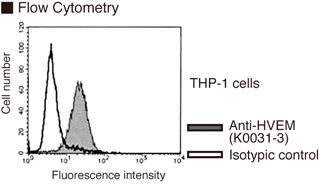Anti-HVEM mAb
| Code | Size | Price |
|---|
| MBL-K0031-3 | 100 ug | £323.00 |
Quantity:
Prices exclude any Taxes / VAT
Overview
Host Type: Mouse
Antibody Isotype: IgG1 κ
Antibody Clonality: Monoclonal
Antibody Clone: 122
Regulatory Status: RUO
Target Species: Human
Application: Flow Cytometry
Shipping:
4°C
Storage:
-20°C
Images
Documents
Further Information
Applications:
FCM - 10-20 ug/mL (final concentration)
Background:
Herpes virus entry mediator (HVEM)
is a member of the tumor necrosis factor receptor (TNFR)
superfamily that has a role in herpes simplex virus entry, in
T cell activation and in tumor immunity. HVEM is
constitutively expressed on CD4+ and CD8+ T cells, CD19+
B cells, CD14+ monocytes, neutrophils and dendritic cells
(DCs). The cytoplasmic region of HVEM binds to several
members of the TNFR-associated factor (TRAF) family,
namely, TRAF1, TRAF2, TRAF3 and TRF5, but not to
TRAF4 or TRAF6, and that it activates transcription factors
NF-κB and AP-1. The co-expression of glycoprotein D
(gD) and HVEM results in the inhibition of the NF-κB
activation that is induced by the HVEM overexpression.
Concentration:
1 mg/mL
Formulation:
100 ug IgG in 100 ul PBS containing 50% glycerol, pH 7.2. Contains nopreservatives.
Gene IDs:
Human: 8764 Mouse: 230979
Immunogen Translated:
Recombinant HVEM
Reactivity:
This antibody reacts with human HVEM
antigen on Flow cytometry.
Shelf Life:
1 year
Source:
This antibody was purified from hybridoma
(clone 122) supernatant using protein A agarose. This
hybridoma was established by fusion of mouse myeloma
cell Sp2/0 with Balb/c mouse splenocyte immunized with
the recombinant HVEM.
Target:
HVEM
References
1) Compaan, D. M., et al., J. Biol. Chem. 280, 39553-39561 (2005)
2) Gonzalez, L. C., et al., PNAS 102, 1116-1121 (2005)
3) Jung, H.W., et al., Exp. Mol. Med. 35, 501-508 (2003)
4) La, S., et al., Mol. Cells 14, 398-403 (2002)
5) Tamada, K., et al., J. Immunol. 164, 4105-4110 (2000)
6) Zhai, Y., et al., J. Clin. Invest. 102, 1142-1151 (1998)
7) Kwon, B.S., et al., J. Biol. Chem. 272, 14272-14276 (1997)
Clone 122 is used in the reference 1) - 3).




